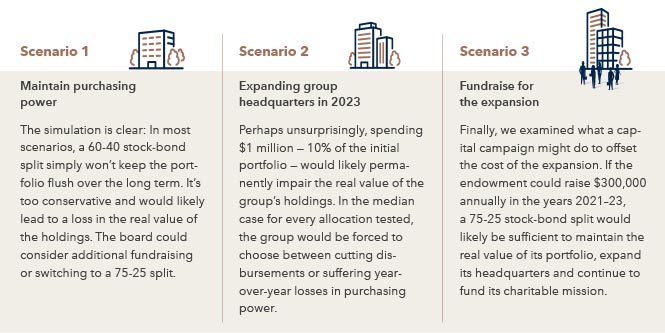Artificial Intelligence
Philanthropy
For many endowments and foundations, it really is all about the journey.
Whether they’re providing scholarships, stocking food pantries or patronizing the arts, many of these organizations have open-ended missions. That means they can’t just plan for the next year or even the next decade — they must plan for perpetuity.
Funding a forever mission is a big commitment. Board members must carefully weigh their resources against the needs they seek to address.
“There’s going to be that push and pull all the time,” says Lisi Dean, a Private Wealth Advisor at Capital Group Private Client Services. “Understanding and evaluating tradeoffs is critical.”
So how does an organization deploy its capital in a responsible way? How can it fund its mission for generations while maintaining a source of working capital?
“It starts with intentionality,” says Aaron Petersen, a senior wealth advisory manager with Capital Group Private Client Services. “The goal to serve in perpetuity needs to be worked into the group’s documents.”
From there, he says, organizations must align their goals, assets and spending requirements. Only then can each entity create an allocation that can help it stand the test of time.
Funding your mission is a holistic process.
An organization’s mission is its raison d’etre — all the fundraising, strategic planning and investing are in pursuit of that goal. But that doesn’t mean the vision is all the group needs. To achieve anything long-term, the group must place its goals into a framework of feasibility.
That’s where tradeoffs come in. There’s a natural tension between growing an endowment and spending its proceeds to support a mission — “while the goals can live in harmony, an organization can’t try to maximize both,” Dean says.
“You have to align the mission with the assets that you have,” Petersen adds.
Careful asset allocation can help serve both ends — it can help investments grow while pursuing cash flow through dividends, bond payments and thoughtful harvesting of mature assets.
And while some groups opt for simple models, such as a 60-40 equity-bond split, allocation is far more nuanced than that, Petersen says. Not only does an organization need to balance its risk, growth and yield profiles, it must also consider variables such as liquidity and inflation protection.
“When your portfolio is distributing, there’s a level of diversification beyond evaluating just the mix of stocks and bonds that needs to be considered,” he explains. “We look for further diversification strategies within the stock and bond categories by pairing investments with varying characteristics that make the portfolio better suited to meet the goals it’s meant to help achieve.”
Any long-term plan must consider your nonprofit’s unique set of circumstances.
Of course, your organization will have its own quirks and peculiarities that can complicate planning. And while these differences can be easy to understand, they often have wide-ranging implications.
For example, a foundation that must distribute a portion of its endowment each year can find itself hard-pressed during a downturn. Not only could it be forced to sell securities at a lower price, but the distribution could have been calculated at an earlier time when they were at a much higher value.
That stress can be compounded for groups whose missions correlate to economic cycles. Charities, for example, often find that their services are more in demand when times are rough — and that can create a situation where an organization is most pressured when its clients are most in need.
“I worked with an organization which was reliant on income that became challenged during the coronavirus downturn,” Dean says. “They needed to know what their options were to continue their mission. We ran some scenario analyses for them, where they drew off their core portfolio. It helped them understand the tradeoffs and what impacts their choices would have over time.”
“We create those models ahead of time to show how a portfolio might react in a variety of situations,” Petersen adds. “It can be a powerful planning tool.”
Plans need to adapt and change along with circumstances.
Finally, no plan is perfect forever. Organizations must be willing to adapt as their needs and the world around them grow and evolve.
Part of that is simply following best practices, Petersen says. Updating investment guidelines and documents such as the investment policy statement is a part of staying on top of the circumstances of the day. Broader changes need to be considered, too. For example, the portfolio should be reviewed on occasion to see if significant market movements, contributions and distributions may impact the long-term goals of the organization.
And, of course, organizations themselves can grow and change.
“A client of ours was looking to raise revenue by increasing ticket sales and felt that improving and upgrading some of their buildings would help achieve that,” Dean says. “We tested some scenarios and, after careful consideration, the client decided to forge ahead with the construction. They felt the tradeoff was worth it.”
Simulated guidance
Even small changes can add up over time, but it’s hard to understand that without the proper context. One of the ways Capital Group Private Client Services helps clients make informed decisions is to run a Monte Carlo simulation and examine potential outcomes in a variety of market conditions.
The following is a simulation for a hypothetical endowment. The charity started 2021 with a portfolio worth $10 million, split 60-40 between equities and bonds. It disburses $315,000 each year, adjusted for inflation — assumed to be 2% for this simulation. The board also wants to expand its headquarters soon, a $1 million task. The endowment is intended to last for perpetuity, so it’s critical that the real value of its portfolio stays constant.

Related Insights
Related Insights
-
Has the AI stock rally run out of gas?
-
Trade
Understanding tariffs in 5 charts -
Trade
Understanding tariffs in 5 charts
